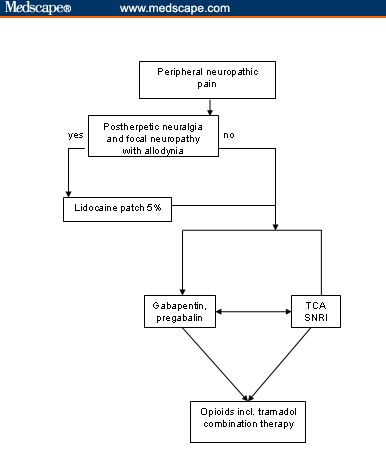An evidence-based algorithm for the treatment of neuropathic pain
- PMID: 17955091
- PMCID: PMC1994866
An evidence-based algorithm for the treatment of neuropathic pain
Abstract
Objective: The purpose of this article is to discuss an evidence-based algorithm that can be implemented by the primary care physician in his/her daily clinical practice for the treatment of patients with neuropathic pain conditions.
Method: A treatment algorithm for neuropathic pain was formulated on the basis of a review of 105 high-quality, randomized, placebo-controlled clinical trials. The number needed to treat (NNT) and number needed to harm (NNH) were used to compare the safety and effectiveness of current treatments for neuropathic pain syndromes. Most of the clinical trials reviewed in the analysis assessed tricyclic antidepressants (TCAs) and antiepileptic drugs (AEDs).
Results: TCAs had the lowest NNT followed by opioids and AEDs, such as gabapentin and pregabalin. The nature of the retrospective calculation of the NNT and NNH involves obvious limitations because of the pooling of studies with different experimental designs and outcomes.
Conclusion: Patients presenting with neuropathic pain are becoming a more frequent occurrence for the primary care physician as the population ages. Evidence-based treatment options allow for the most efficient and effective pharmacotherapy regimen to be implemented.
Figures


References
-
- Schmader KE. Epidemiology and impact on quality of life of postherpetic neuralgia and painful diabetic neuropathy. Clin J Pain. 2002;18:350–354. - PubMed
-
- Foley KM. Opioids and chronic neuropathic pain. N Engl J Med. 2003;348:1279–1281. - PubMed
-
- Davis MP, Walsh D. Epidemiology of cancer pain and factors influencing poor pain control. Am J Hosp Palliat Care. 2004;21:137–142. - PubMed
Publication types
MeSH terms
Substances
LinkOut - more resources
Full Text Sources
Medical
